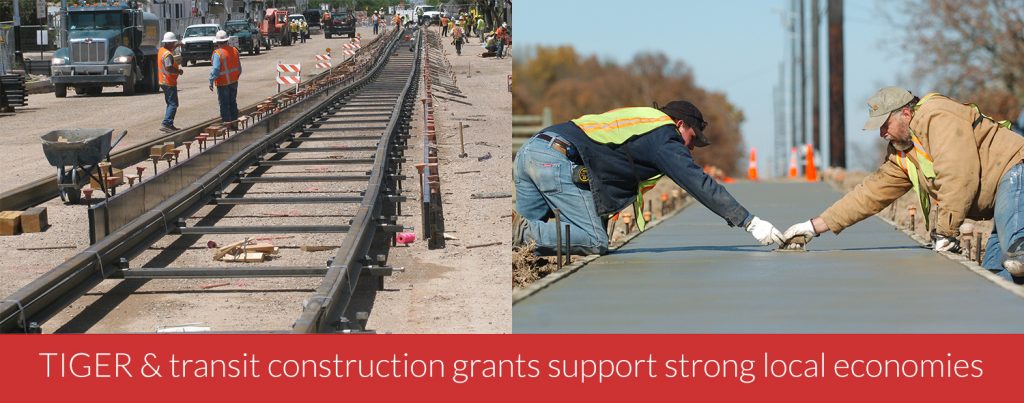Elected officials and local organizations: Support TIGER & public transit funding
Facing the prospect of severe cuts from the Trump administration and Congress, T4America is looking for elected officials and organizations to show their support for investing in smart projects to move goods, move people and support the local economies that our nation’s prosperity is built on.

Updated 9/6/2017 9:00 a.m. — The letter is closed. We’ll publish the final letter and share the signatories soon. Thanks!
Calling all elected officials, local, civic and business leaders, and local, regional or state organizations! Sign a letter urging those currently assembling the federal transportation budget for the upcoming year (FY 2018) to prioritize funding for TIGER competitive grants, new transit construction, and passenger rail programs.
Read the full letter and sign it today — we’re aiming to deliver it before the end of August. Ed note: This letter is intended for organizations and is not open for individuals, other than elected officials at any level.
Where do we stand in the budget process?
For these three programs, this simple chart below shows four things: the current funding levels for this year, what the President proposed in his budget earlier this year, and what was recently approved by appropriations committees in the House and the Senate.
| Enacted 2017 levels | President Trump's request for 2018 | House 2018 Appropriations | Senate 2018 Appropriations | |
|---|---|---|---|---|
| TIGER Grants | $500 million | $0 | $0 | $550 million |
| Transit Capital Grants | $2.4 billion | $0 | $1.75 billion | $2.133 billion |
| Amtrak & passenger rail | $1.495 billion | $795 million (All cuts come from eliminating federal funding for all long-distance routes) | $1.4 billion | $1.6 billion |
| TOTAL THUD FUNDING | $57.65 billion | $47.4 billion | $56.5 billion | $60.058 billion |
As you can see, while committees in the Senate ignored the president’s call to eliminate TIGER and funding for new transit construction outright, those final decisions will be made by Congress as they debate the budget on the floor and then try to reconcile their different versions. (Worth noting: The House proposed eliminating TIGER funding and a barebones budget for keeping in-progress transit projects moving, which means that’s their starting point on negotiations.)
What we’re asking for is for Congress to approve a budget that fully funds the FAST Act, the current transportation authorization, already agreed to by Congress and approved by a bipartisan vote back in 2015.
More background is below:
TIGER
The majority of all federal transportation dollars are awarded to states and metro areas in a way to ensure everyone gets a share, regardless of how they’re going to spend those dollars or how well-conceived their projects are. TIGER operates differently.
The TIGER program has illustrated a productive way to use a small amount of money (about $500 million annually since 2009) to incentivize smarter projects based on their merits. This fiercely competitive program is one of the few ways that local communities of almost any size can directly receive federal dollars for their priority transportation projects. Projects vying for funding compete against each other on their merits to spend the dollars more effectively. They also bring more private, local, or state dollars to the table. Through the first seven rounds, each TIGER dollar brought in 3.5 non-federal dollars, in contrast to federal money for building new roads, for example, which only bring in about 20 state/local cents for each 80 federal cents.
Transit Capital Investment Grants
The Transit Capital Investment Grants program (often broadly referred to as New Starts) supports metro areas of all sizes that are investing their own money in building or expanding transit service.
While making the case for eliminating the program, the Trump Administration recently stated that “localities should fund these localized projects,” but local voters and leaders are doing that already, putting their own skin in the game to meet the growing demand for well-connected locations served by transit. At the ballot box last November alone, voters approved more than $200 billion dollars in tax increases to invest in these projects. But cities of all sizes are counting on the federal government to continue supporting these bottom-up efforts, as they’ve done for decades. Eliminating this program or even just reducing its funding will threaten their economic prospects and their ability to satisfy the booming demand from residents and employers alike for well-connected locations served by transit.
Passenger rail
President Trump proposed cutting Amtrak’s budget nearly in half, with nearly all cuts coming from eliminating long-distance passenger rail service. Funding for the Northeast Corridor would survive, as would the funding for state-supported routes.
But neither chamber heeded this call from the administration: the House approved slightly less funding compared to last year, while the Senate provided the full amount outlined in the FAST Act, allocating competitive funds for safety, state of good repair for the Northeast Corridor, and operating and capital support for restored or new passenger service throughout the rest of the country.




















Pingback: Today’s Headlines – Streetsblog St. Louis